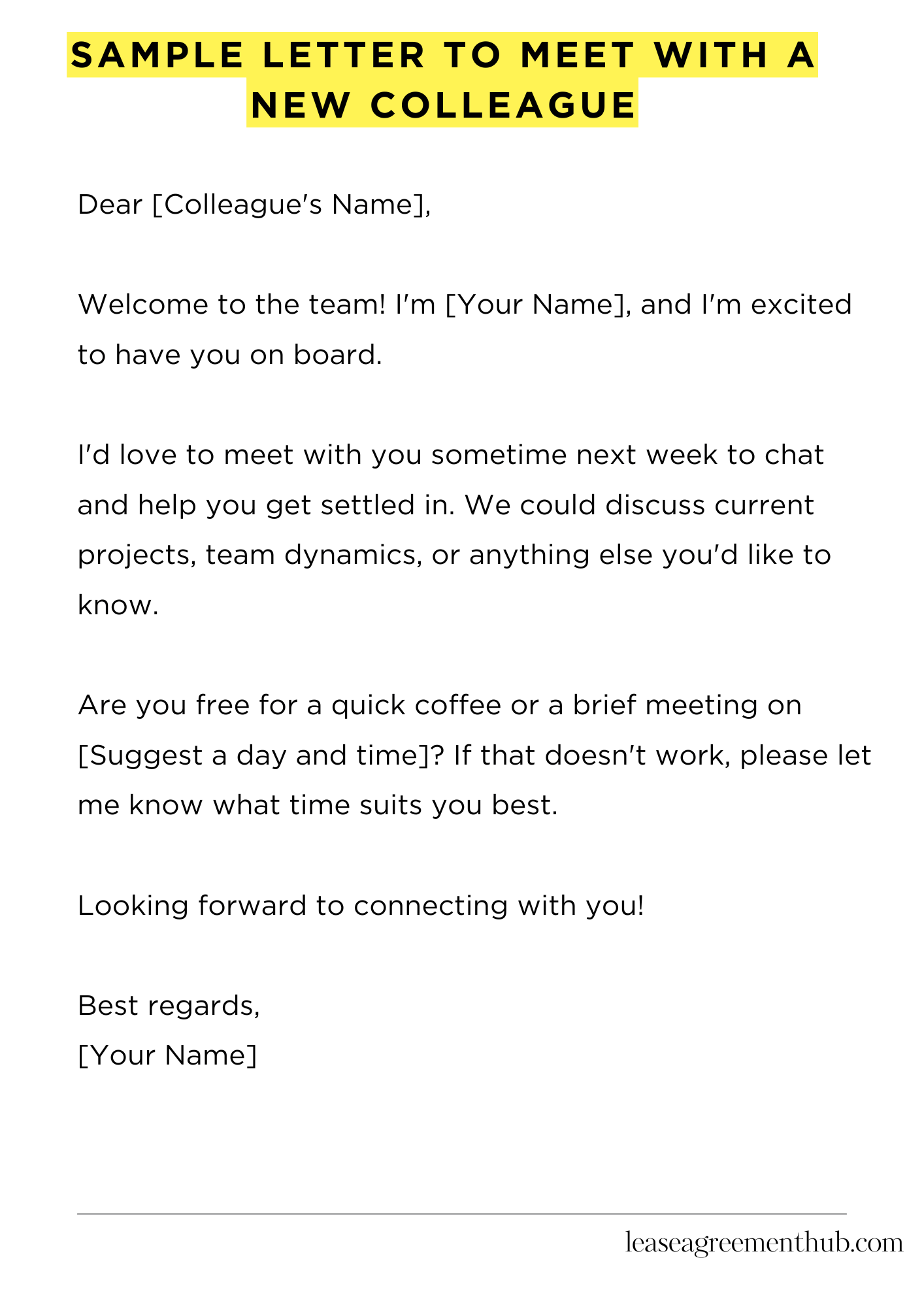A “Sample Letter To Meet With a New Colleague” is an email or note. It’s used to introduce yourself. You want to connect with someone new at work. It helps break the ice.
Need to write one? We get it. Starting a new job can be awkward. Meeting new teammates? It can be tough. We’re here to help you make a great first impression.
Ready to make introductions easy? We’ve got your back. We’ll share templates and examples. These samples will help you write the perfect letter. Let’s get started!
Sample Letter To Meet With A New Colleague
Dear [Colleague’s Name],
Welcome to the team! I’m [Your Name], and I’m excited to have you on board.
I’d love to meet with you sometime next week to chat and help you get settled in. We could discuss current projects, team dynamics, or anything else you’d like to know.
Are you free for a quick coffee or a brief meeting on [Suggest a day and time]? If that doesn’t work, please let me know what time suits you best.
Looking forward to connecting with you!
Best regards,
[Your Name]

How to Write a Letter to Meet With a New Colleague
Subject Line: The Overture
- Craft a subject line that is both succinct and alluring. Think “Eager to Connect: [Your Name]” or “Welcome to the Team, [Colleague’s Name]! Let’s Chat.”
- Avoid nebulous greetings. Specificity piques interest.
Salutation: The Cordial Greeting
- Begin with a professional yet affable greeting. “Dear [Colleague’s Name],” is a safe and universally accepted starting point.
- Refrain from overly informal salutations unless the company culture explicitly endorses such camaraderie from the get-go.
Introduction: Breaking the Ice
- Briefly introduce yourself and your role within the company. For instance: “I’m [Your Name], a Senior Project Manager here at [Company Name].”
- Mention how long you’ve been with the company. It provides context and instills a sense of familiarity.
The Body: Expressing Intent
- Clearly articulate your desire to schedule a meeting. “I’d love to connect with you to discuss your role and how we can synergize our efforts.”
- Suggest a specific timeframe. “Would you be available for a brief virtual rendezvous sometime next week?”
- Propose a few tangible topics for your confab. This shows you’ve put thought into the interaction.
Offer Value: Beyond the Pleasantries
- Demonstrate that meeting with you offers concrete value. Perhaps you can share institutional knowledge or insights into ongoing projects.
- For example: “I have some contextual information regarding the [Project Name] initiative that I believe would be beneficial for you.”
Call to Action: Seizing the Moment
- Conclude with a clear call to action. “Please let me know what time works best for you to connect. I’m looking forward to our dialogue.”
- Make it effortless for your colleague to respond. Offer multiple avenues: “You can reply to this email or reach me directly at [Phone Number].”
Closing: A Graceful Exit
- End with a professional and courteous closing. “Best regards,” or “Sincerely,” are both acceptable options.
- Followed, of course, by your full name and job title. Ensure your contact information is readily available.
Frequently Asked Questions: Sample Letter to Meet a New Colleague
This section addresses common inquiries regarding crafting an effective introductory letter to a new colleague. It offers guidance to ensure a professional and welcoming first impression.
Why should I send an introductory letter to a new colleague?
Sending an introductory letter helps break the ice, fosters a welcoming environment, and initiates a professional relationship.
What information should the letter include?
The letter should include a brief introduction of yourself, your role, your team, and an invitation to meet or connect.
How formal should the tone of the letter be?
Maintain a professional and respectful tone. Adapt the formality to align with your company culture.
When is the best time to send the letter?
Send the letter shortly after the colleague joins, ideally within their first week, to show your proactive interest.
Can I include my contact information in the letter?
Yes, include your email address and phone number to facilitate easy communication and scheduling a meeting.
Related: